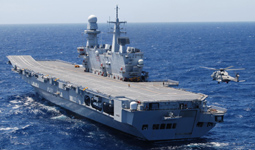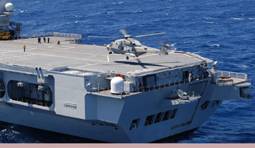-
Numero contenuti
3.029 -
Iscritto il
-
Ultima visita
-
Giorni Vinti
6
Risposte pubblicato da Tuccio14
-
-
Certo è che il rapporto peso/potenza non sia dalla sua però...
-
Ebbene sì: SAAb si lancia con il Gripen nel mercato dei caccia imbarcati. Coi piedi di piombo, si tratta praticamente solo di uno studio di fattibilità, ma l'intenzione c'è.
Saab to complete Sea Gripen design work in UKSaab is to recruit a small team of engineers to staff a new design centre for its Sea Gripen concept in the UK, in an effort that could eventually lead to the construction of a flight demonstrator.
The Swedish company announced its plan following a 24 May meeting with Ministry of Defence officials in London, where it is also to open a new headquarters to accommodate the project team.
The move comes as Saab chief executive Håkan Buskhe has revealed a strategy to significantly expand the company's presence in the UK by pursuing fresh business opportunities. "The MoD is looking for competition," he said.
To open within the next few months following the recruitment of around 10 personnel, the design centre "will capitalise on the UK's maritime jet engineering expertise", Saab said. "Its first project will be to design the carrier-based version of the Gripen new-generation multi-role fighter aircraft based on studies completed by Saab in Sweden."
A concept-design phase lasting roughly 12-18 months will follow, after which Saab could choose to prepare a flight demonstrator, most likely at its Linköping site in Sweden. It hopes to work in partnership with selected UK companies to advance the project, as the nation's industry already provides 28% of the content for the Gripen NG.
Saab has described its Sea Gripen as an "ideal replacement for existing fleets and new [aircraft] carrier nations", and named Brazil and India as possible future customers. The concept was first explored around five years ago, and sources have said that the aircraft would be suitable for use on vessels with a displacement as low as 25,000t. Deliveries could be made from 2018.
Saab has around 200 employees in the UK, but according to Buskhe, "there's no reason why we couldn't be 10 times as big here. We believe the UK is a good ground to make an expansion from. We believe we have a gap to fill, and that we can show that it's possible to acquire extremely fine products that are affordable.
"When you have cuts it's time to look into your normal procurement processes and challenge patterns that were used in the past. We believe we have something to bring to the table."
Acquisitions could be one possible route to meeting the growth ambition, but Buskhe said that any such move "must keep to the core values of Saab: that we can increase the product performance and decrease cost". The company has a net cash position of around SKr4 billion ($631 million).
-
Cosa che invece non fa il Ghana, sempre per motivi finanziari: nel 2009 aveva "prenotato" quattro C-27J in Foreign Military Sale alla Defense Security Cooperation Agency statunitense, più due turboeliche di scorta e tutta l'assistenza del mondo, per la modica cifra di 680 milioni di dollari. Ora ha rinunciato alla FMS ed ha optato per due esemplari del COSO, che ovviamente costano molto meno sia in proporzione che complessivamente (due invece di quattro senza scorta di motori).
-
C'è da dire che anche il Silent Eagle ha delle doti stealth non rimarcate come l'F-35 ma diciamo dhe è attualmente è la 3 proposta di un caccia stealth dopo l'F-22 e l'F-35...
Ma anche no dai, abbiamo ripetuto fino allo spasmo che un caccia che non sia nato come stealth non potrà diventarlo mai... Ok finchè si parli di RCS ridotta ed accorgimenti per ridurre le tracce elettromagnetica ed infrarossa, ma stealth proprio no...
-
Io parlavo dell'opinione pubblica, è ovvio che sapesse pià di quanto potesse essere rivelato.
Comunque sarei curioso di sapere di che nazionalità fosse l'aereo che ha sganciato le bombe, e magari anche sapere di che tipo... Tra l'altro durante questa campagna pare siano state usate addirittura bombe da esercitazione, in pratica dei cilindri di cemento con il kit di guida fatti piovere dal cielo sui veicoli non blindati. Il vantaggio è quello di ridurre a zero i danni collaterali.
-
La lingua in uso è l'inglese, che fortunatamente i piloti dell'AMI conoscono nella stragrande maggioranza dei casi molto bene (per lo meno in base alla mia esperienza), ma non credo che tra pilota ed istruttore di stessa nazionalità si usi l'inglese. Con tutto che la metà delle parole che si dicono in cabina o nelle fasi "ground" dell'addestramento sono inglesi o inglesizzate, a cominciare proprio da "briefing" e "debriefing", entrate nell'uso comune anche tra i reparti dell'AMI.
-
Intanto il best seller di AW può fregiarsi del titolo "combact proven"!
 E' un eufemismo ovviamente, anche se effettivamente due AW-139 hanno assistito i Mirage-2000 della Quatar Emiri Air Force in veste di vedetta SAR sull'isola di Creta.
E' un eufemismo ovviamente, anche se effettivamente due AW-139 hanno assistito i Mirage-2000 della Quatar Emiri Air Force in veste di vedetta SAR sull'isola di Creta.Tra l'altro si aprono spiragli in Thailandia per AgustaWestland nel profittevole mercato dei sostituti dello Huey: la flotta di 25 velivoli è al capolinea (ne sono caduti tre in pochissimo tempo) ed il governo ha annunciato di voler acquisire 30 nuove macchine. I concorrenti non sono ancora stati specificati, ma dubito che con l'alluvione in corso da mesi avranno la forza per pensare alle commesse militari, con tutto che gli elicotteri, specialmente quelli della classe dello Huey, in queste occasioni sono indispensabili...
-
Non so se ne abbiamo già parlato ma l'NH-90 è in corsa, con i soliti noti, per equipaggiare la Indian Navy:
EC725, NH90 S-70B and MH-60R in frame as Indian navy starts hunt for anti-submarine warfare helicopter replacement
The Indian navy has begun evaluating four proposals for its anti-submarine warfare (ASW) helicopter replacement requirement, writes Brendan Sobie.
Industry sources say bids have been submitted by Hindustan Aeronautics (HAL) offering the Eurocopter EC725, NH Industries the NH90, Sikorsky the S-70B and by the US Navy for the new Sikorsky-built, Lockheed Martin integrated MH-60R.
The Indian navy is looking to replace its ageing Westland Sea King fleet, which when delivered in the 1980s consisted of over 40 aircraft, and initially plans to acquire 16 replacements and take eight options. The navy will conduct field evaluations after finishing technical evaluations, but the manufacturers have not yet been provided with a schedule for site visits. A contract could be signed as early as next year, but sources say the navy may opt to delay the acquisition and instead buy a proposed 10t indigenous helicopter from HAL.
The Indian manufacturer plans to select a foreign company to help it launch a five-year indigenous development or co-development programme. Sources say Eurocopter and Sikorsky are now preparing proposals, which will be submitted to HAL around mid-year. Sources say Bell also met with HAL earlier this year to discuss co-developing a new helicopter that would have expanded Bell’s portfolio into the 10t category, but the US manufacturer has decided against submitting a bid.
AgustaWestland, which did not respond to the navy’s tender because its EH101 is too large for the requirement, is also unlikely to submit a bid for the HAL project.
Sources say Eurocopter is the frontrunner over Sikorsky because it has already teamed with HAL to offer the EC725 in response to the navy’s tender and the duo is also planning joint bids for other Indian helicopter acquisition programmes.
Il tutto mentre il 20 luglio il primo NH-90 della Marina Militare ha appontato sul Cavour (link di Dedalo News) e l'Olanda modifica l'ordine: 8 elicotteri su 20 saranno predisposti per imbarcare la suite di missione ma saranno sprovvisti della stessa.
Le foto dell'ammiraglia italiana con il nuovo elicottero in avvicinamento:


-
Non c'è una discussione su questo modello, mi sembra opportuno aprirla. Inizio con la scheda presente sul sito di AgustaWestland.
AgustaWestland, a Finmeccanica company, is proud to unveil the AW169, a new generation multi-purpose twin engine light transport utility helicopter designed in response to the growing market demand for higher mission flexibility and multi-role capability in the 4.5 ton class. The AW169 has been designed to meet the current and anticipated stringent requirements of commercial and government operators worldwide. The aircraft incorporates several new technology features, incorporated to provide the highest levels of safety and operational benefits for customers. A new generation, advanced aerodynamic rotor design will deliver excellent performance in the most demanding operating environments. The AW169 eco-friendly design also benefits from extensive use of composites, advanced airframe aerodynamics, next generation navigation avionics and state-of-the-art systems. Speaking at the unveiling ceremony Giuseppi Orsi, CEO, AgustaWestland said “We are unveiling the AW169 hear at Farnborough because of the real and exciting potential this aircraft will have for the UK in terms of the market and industrially. Our Company’s commitment to the UK industrial base I believe is widely recognised and the AW169 is another opportunity for the UK to support and participate in a major new programme.”
Pier Francesco Guarguaglini, Finmeccanica Chairman and CEO, commented “Unveiling a brand new state-of-the-art helicopter fitted with the very latest in technology at Farnborough provides clear evidence of Finmeccanica’s committment to innovation and particularly to the United Kingdom where our industrial base is strong and offers a major contribution to our success both in the country and worldwide.” Graham Cole, Managing Director, AgustaWestland went on to say “I am delighted that AgustaWestland in Yeovil is to play an important role in the design, development and production of the AW169. We see a large market for the AW169 and the real prospect of a production line for a AgustaWestland commercial helicopter in Yeovil. He added “ We have already formed a UK parapabulic team which will vigorously pursue with the AW169 and our other products, all UK parapublic opportunities. AW169s which are acquired within the UK will be built and supported in the UK and will be key to opening the production line early.” Dr Vince Cable MP, Secretary of State for Business, Innovation and Skills, said “The Government recognises and appreciates the significant investments Finmeccanica have made into the aerospace and defence industries in the UK in recent years and is delighted that this continues with the launch of the AW169. The AW169 is indeed an exciting project that typifies the type of project which will sustain and grow our domestic high technology engineering and manufacturing base into the future.”

The AW169’s avionic suite introduces the very latest technology for maximum situational awareness and all-weather operations, including a full digital NVG compatible cockpit with three 8” x 10” large area displays (AMLCD) with enhanced graphics capability. A 4-axis digital automatic flight control system (DAFCS) with dual Flight Management System (FMS) minimises crew workload allowing single/dual pilot VFR/IFR operations. The avionics suite also complies with satellite-based navigation, communication and surveillance requirements and has the capability to perform satellite-based IFR LPV (localizer performance with vertical guidance) approaches to maximize round-the-clock utilisation of the helicopter. Safety enhancing avionics such as Terrain Awareness Warning Systems, airborne collision avoidance systems and the innovative ‘Guardian’ obstacle detection device can be added to the standard avionic configuration. Environmental friendliness is core to the AW169 design. New generation advanced turboshaft engines for maximum efficiency/low emissions and advanced rotor aerodynamics producing very low external noise, well below regulatory limits, make the AW169 an eco-friendly helicopter according to the very latest standards. This eco-friendly design also benefits from a wide use of composites, advanced airframe aerodynamics, next generation navigation avionics and state-of-the-art technology. The two new generation advanced FADEC-controlled Pratt & Whitney Canada PW210 turboshaft engines deliver high power with maximum efficiency and low emissions. The AW169 can carry two pilots and up to 8/10 passengers, or alternatively two stretchers, in the large unobstructed main cabin accessible via two large sliding cabin doors. The AW169 has been developed in accordance with the latest FAA/EASA Part 29 certification standards and complies with the most stringent safety requirements, including a full crashworthy structure and seats, engine burst containment and one engine inoperative (OEI) capability in the entire envelope. The AW169 has been engineered with maximum maintainability in mind with high TBOs (Time Between Overhaul) for the power plant and main components, a reduced number of life-limited parts, high reliability and low maintenance requirements to maximise operational effectiveness. Thanks its modern design features and capabilities, the 4.5 ton class AW169 is aiming to be the most advanced and cost/effective answer for EMS/SAR, law enforcement, passenger and offshore transport and utility markets. According to mission requirements, the AW169 can be customised with a wide range of equipment including weather radar, FLIR, rescue hoist, cargo hook, search light and medical interior just to name a few. The AW169 is the first brand-new type introduced in its market segment in decades and AgustaWestland forecasts a potential market for almost 1000 aircraft over approximately 20 years.

Ho colto l'occasione poichè AW ha venduto i primi elicotteri di questo modello: tre in Canada (Capitale Hélicoptère) per trasporto VIP ed elisoccorso urgente, più altri due in Gran bretagna (WNAA) in versione air ambulance, questi ultimi da consegnarsi nel 2015.
-
solo fino alle elezioni del 24 poi anche questa formalita fu abrogata
Tra l'altro.
-
Non è un azzardo dirlo. Non per difenderla a spada tratta, ma considera anche che la prima linea dell'AMI non è supportata da moltiplicatori di forze e da costanti aggiornamenti quanto la RAF. Come ripetiamo spesso nel forum in Italia si preferisce contare sui numeri piuttosto che sulla qualità, che comunque rimame elevata.
-
Il Tornado è destinato ad essere pensionato tra una quindicina di anni, come in Italia dopotutto. Non consideriamo però solo il numero effettivo di caccia: tieni a mente che un EF-2000 riesca a produrre praticamente il doppio di numero di ore di un Tornado, necessitando quindi di numeri inferiori a parità di efficacia dello strumento aereo nel suo insieme.
-
Non credo abbiano la stessa RCS frontale, in particolare a causa della posizione di motori e ventole, non coperti da dotti ad S come in tutti i moderni caccia. Io comunque credo abbia più che ottime possibilità, dopotutto la ROKAF schiera già l'F-15 con successo.
-
Bello! Gradevole anche il logo per la commemorazione dei 150 anni dell'Unità d'Italia. La cosa che mi piace di più è che assomigli molto al modellino della collezione della Gazzetta...

-
Anche durante il fascismo si poteva votare, peccato che si potesse solo esprimere un parere (favorevole o contrario) sui parlamentari imposti dal Gran Consiglio del Fascismo.
-
La RAF ha in ordine 160 macchine, con cui ha intenzione di far fronte sia ai compiti di superiorità aerea che di bombardamento. Attualmente è il maggior utente della macchina e quello che ne abbia sviluppato maggiormente le potenzialità. L'intenzione è di avere una prima linea di circa 300 macchine tra Typhoon e Lightning II, questi ultimi tutti in versione C, il cui numero esatto è ancora da stabilire.
La Luftwaffe ha in ordine 143 EF-2000 e partecipa come osservatore al programma JSF, cosa che potrebbe far intendere una futura acquisizione del velivolo. Ciò che è dato per scontato, però, è che la Luftwaffe assegnerà all'EF-2000 ugualmente compiti di superiorità aerea e bombardamento.
Per l'Italia la vedo grigia rispettare i numeri, fatto sta che rimanga uno degli stati che abbia investito più seriamente nel programma.
-
Più che altro senza nessuno che gli sborsi la parcella... Comunque l'ONU ha anche avviato un'indagine per stabilire le cause della morte, credo che un po' tutti avrebbero preferito dare seguito al mandato di cattura internazionale.
Ora che stanno per concludersi le attività della NATO in Libia cosa dobbiamo aspettarci?

-
Dopo del Messico anche l'Australia torna sui suoi passi a seguito della selezione del COSO...
-
La Spagna ha già deciso di tagliare? Fin'ora si è parlato solo delle altre tre nazioni del consorzio, a meno che non mi sia sfuggito qualcosa...
Comunque la situazione della prima linea della Luftwaffe è in declino, non hanno neanche in programma di acquistare gli F-35...
-
La gran parte dei costi sono a carico dell'AMI, qualcosina ci mette anche la NATO e qualcosina anche gli USA. Da che io sappia i programmi di addestramento congiunti lavorano praticamente come agenzia, ossia effettivamente vendono corsi di addestramento ricevendo fondi accessori da alcune nazioni od organizzazioni, come appunto la NATO. Per lo meno così verrà strutturato l'AEJPT europeo.
-
Infatti era diretta a quelli che, dopo più di 600 post, avrebbero potuto scrivere "ma perchè l'AMI non ordina un certo numero di M-346K per sostituire cli AMX?". Poi figurati, possiamo parlarne fino a consumarci le dita!

Comunque quello che intendevo è che l'M-346 è nato innanzitutto come addestratore, mentre il T-50 è stato pensato sin dall'inizio come un nuovo F-5. Poi probabilmente all'Aermacchi si sono accorti del potenziale della macchina ed hanno puntato anche sulla versione da combattimento, ma senza post bruciatore la vedo grigia, al massimo può dedicarsi all'attacco al suolo, mentre il T-50 potrebbe diventare anche un discreto caccia.
-
Grazie per i chiarimenti sul Lakota, evidentemente sono molto soddisfatti della macchina, come tutti gli altri utenti, militari e non, sparsi per il globo. In un'ottica di economie di scala e standardizzazioni sarebbe la miglior scelta per sostituire il mitico Kiowa Warrior, anche se non sono a conoscenza delle doti di agilità della macchina.
Tornando in topic, speriamo che i vertici delle forze armate statunitensi capiscano come, pur non essendo statunitense, lo Spartan possa essere l'aereo giusto al momento giusto. In Afghanistan è molto apprezzato.
-
.... salvo che, in Aermacchi, vi stiano lavorando senza darvi eccessiva pubblicità ....
Esattamente. D'altronde i clienti richiedono sempre di poter impiegarlo nell'addestramento avanzato con secondarie capacità nel'attacco al suolo e nella polizia aerea. In una delle sue prime apparizioni (non ricordo se a Farnborough o a Le Bourget) fu esibito con un bel cucuzzaro appeso alle ali, comprese delle rotaie "alla russa" per missili a guida infrarossa aria/aria a corto raggio, senza considerare la predisposizione (stabilita fin dalle prime fasi della progettazione) di montare un radar nel muso.
Di sicuro il fratello russo è maggiormente predisposto all'impiego in combattimento, dopo tutto la Russia ha una diversa prospettiva di export, mentre l'M-346 è innanzitutto un addestratore, con secondarie capacità di impiego bellico.
 :angry:
:angry:  E non riapriamo la questione della versione cattiva del Master!!!
E non riapriamo la questione della versione cattiva del Master!!!  :angry:
:angry: 
-
ma perchè postate foto vecchie di mesi?
A parte tutto credo che l'abbia postata poichè nell'articolo viene rimessa in discussione, dopo mesi, la natura di quell'abbattimento.
Io mi chiedo anche come mai il Times of Malta sia in lingua inglese a tutt'oggi, almeno fosse in maltese... Probabilmente in questo modo riescono ad avere accesso ad un mercato più ampio di quello esclusivamente isolano, anche se mi domando seriamente, a parte i numerosi emigrati maltesi nel Commonwealth, chi possa essere interessato, fuori di Malta a leggere il Times of Malta.
Le lingue ufficiali dello stato di Malta sono inglese e maltese a pari livello, con la differenza che l'inglese abbia una maggior diffusione. Wikipedia riporta che anche l'italiano sia parlato dal 66% della popolazione.









F-X III
in News Aviazione
Inviato
Sì ma a questo punto diventano parimenti alternative agli stealth puri anche Gripen e Growler, per non parlare del Typhoon e sopratutto del Rafale, progettato fin dall'inizio per avere una ridotta segnatura radar ed infrarossa ed in seguito ancor più spinto in questa direzione.